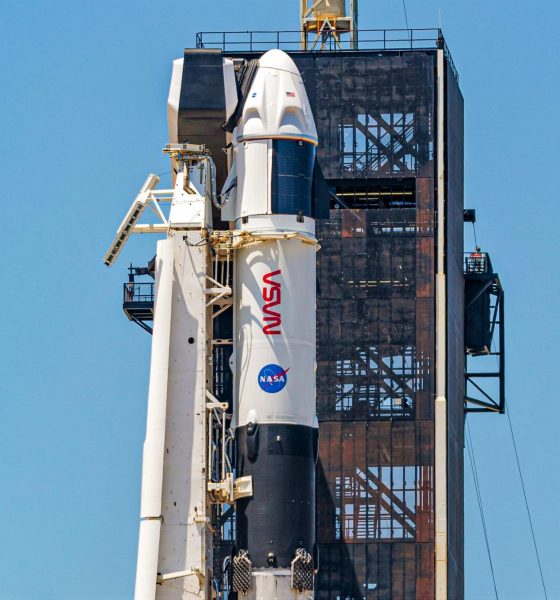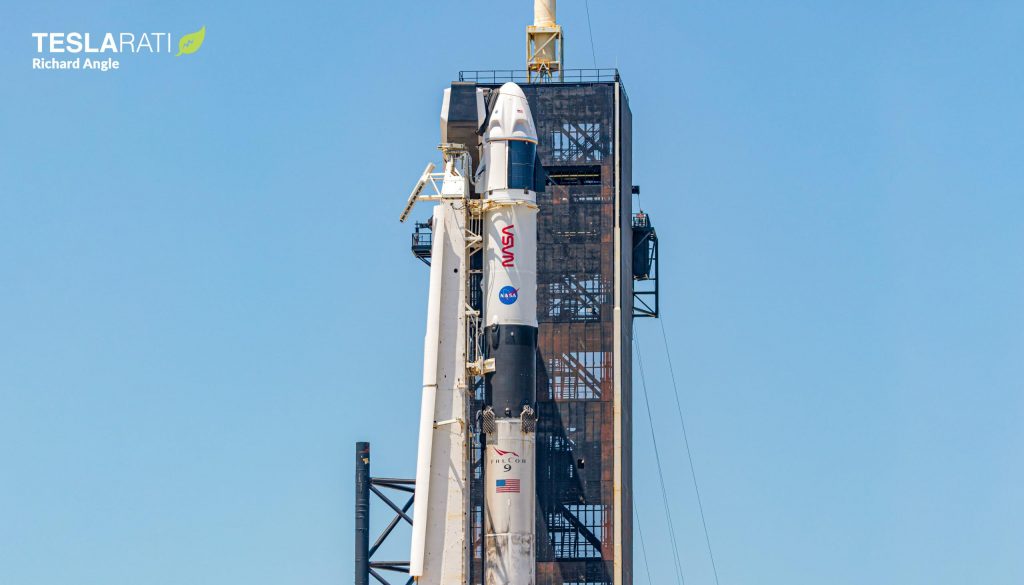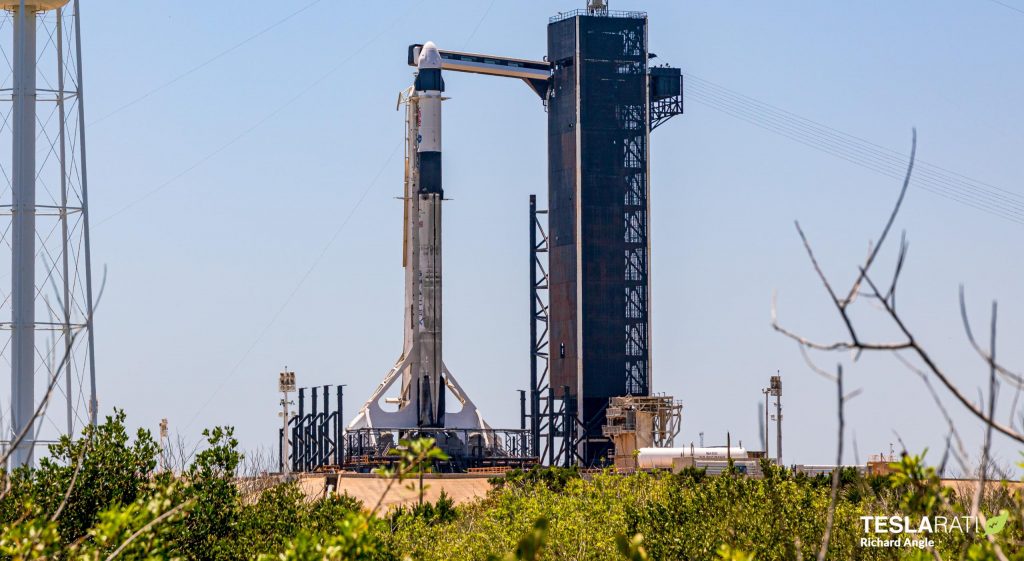

News
NASA, SpaceX set for historic Friday astronaut launch with reused booster and capsule
Update: NASA and SpaceX have confirmed that they are set for a historic astronaut launch with a reused Falcon booster and Dragon capsule on Friday, April 23rd.
Delayed from April 22nd by weather hundreds to thousands of miles downrange, those sea conditions – appear to have settled down – at least for now – and weather at the launch pad itself is about as good as it gets on the central Florida coast.


An official livestream hosted by NASA and SpaceX will begin around four hours prior to Crew-2’s 5:49 am EDT (09:49 UTC) liftoff. Stay tuned for updates and tune in below around 1:49 am EDT to watch all of the launch proceedings live.
SpaceX’s second operational Dragon astronaut launch and one of the biggest milestones in the history of rocket and spacecraft reuse will have to wait until Friday after bad ‘abort’ weather tripped up an otherwise excellent Thursday launch attempt.
Aside from nature’s boundless chaos, all other elements of SpaceX and NASA’s Crew-2 astronaut launch are in excellent condition and ready for flight – now scheduled no earlier than 5:49 am EDT (09:49 UTC) on Friday, April 23rd.
As previously discussed on Teslarati, both Falcon 9’s first stage and Crew Dragon’s recoverable capsule are flight-proven, making Crew-2 the first time in history that a private company – or anyone, for that matter – has attempted to launch astronauts with a reused liquid rocket booster or flight-proven space capsule, let alone both at the same time.
“In essence, success would mean that SpaceX has unequivocally proven that a private company can develop – nearly from scratch – methods of rocket and spacecraft reusability that are so successful and reliable that perhaps the most risk-averse customer on Earth is willing to place the lives of its astronauts in the hands of those flight-proven spacecraft and rockets. If SpaceX can accomplish that feat with Falcon 9 and Crew Dragon, there is no practical reason to doubt that it can be repeated with Starship – a vehicle that has already piqued NASA’s interest.”
Teslarati.com – 15 April 2021
Thus far, both Falcon booster B1061 and Dragon capsule C206 have sailed through their prelaunch processing, most recently culminating in a flawless static fire test and ‘dry dress’ rehearsal late last week. Since then, NASA and SpaceX have continued to analyze data and inspect hardware but are otherwise simply waiting on the weather. Both on Thursday and Friday, weather at the pad itself (and in the region of the Atlantic where Falcon 9’s first stage will be landing) is about as good as it gets, offering just a 10-20% chance of conditions that could scrub the launch.
Unfortunately, things aren’t quite that easy. Due to the fact that NASA and SpaceX have to ensure that thorough contingency plans are in place in case of a launch failure and Dragon abort, Crew Dragon launches also have to take into account weather conditions and sea states across a ~3200-kilometer (~2000 mi) corridor stretching from the Central Florida coast to Ireland. With such a vast expanse of the ocean in focus, the odds that all possible abort scenarios will result in a safe splashdown and astronaut recovery start to become akin to winning the lottery.

In the case of Crew-2, the weather somewhere along that vast tract of the Atlantic Ocean isn’t behaving, leading NASA and SpaceX to delay the launch from Thursday to Friday. If Friday’s attempt suffers the same fate, orbital mechanics will push the next launch opportunity to Monday, April 26th. As always, SpaceX will stream the launch live. Tune in around four hours before liftoff at SpaceX.com.

News
Elon Musk’s Grokipedia surges to 5.6M articles, almost 79% of English Wikipedia
The explosive growth marks a major milestone for the AI-powered online encyclopedia, which was launched by Elon Musk’s xAI just months ago.

Elon Musk’s Grokipedia has grown to an impressive 5,615,201 articles as of today, closing in on 79% of the English Wikipedia’s current total of 7,119,376 articles.
The explosive growth marks a major milestone for the AI-powered online encyclopedia, which was launched by Elon Musk’s xAI just months ago. Needless to say, it would only be a matter of time before Grokipedia exceeds English Wikipedia in sheer volume.
Grokipedia’s rapid growth
xAI’s vision for Grokipedia emphasizes neutrality, while Grok’s reasoning capabilities allow for fast drafting and fact-checking. When Elon Musk announced the initiative in late September 2025, he noted that Grokipedia would be an improvement to Wikipedia because it would be designed to avoid bias.
At the time, Musk noted that Grokipedia “is a necessary step towards the xAI goal of understanding the Universe.”
Grokipedia was launched in late October, and while xAI was careful to list it only as Version 0.1 at the time, the online encyclopedia immediately earned praise. Wikipedia co-founder Larry Sanger highlighted the project’s innovative approach, noting how it leverages AI to fill knowledge gaps and enable rapid updates. Netizens also observed how Grokipedia tends to present articles in a more objective manner compared to Wikipedia, which is edited by humans.
Elon Musk’s ambitious plans
With 5,615,201 total articles, Grokipedia has now grown to almost 79% of English Wikipedia’s article base. This is incredibly quick, though Grokipedia remains text-only for now. xAI, for its part, has now updated the online encyclopedia’s iteration to v0.2.
Elon Musk has shared bold ideas for Grokipedia, including sending a record of the entire knowledge base to space as part of xAI’s mission to preserve and expand human understanding. At some point, Musk stated that Grokipedia will be renamed to Encyclopedia Galactica, and it will be sent to the cosmos.
“When Grokipedia is good enough (long way to go), we will change the name to Encyclopedia Galactica. It will be an open source distillation of all knowledge, including audio, images and video. Join xAI to help build the sci-fi version of the Library of Alexandria!” Musk wrote, adding in a later post that “Copies will be etched in stone and sent to the Moon, Mars and beyond. This time, it will not be lost.”
News
Tesla Model 3 becomes Netherlands’ best-selling used EV in 2025
More than one in ten second-hand electric cars sold in the country last year was a Tesla Model 3.

The Tesla Model 3 became the most popular used electric car in the Netherlands in 2025, cementing its dominance well beyond the country’s new-car market.
After years at the top of Dutch EV sales charts, the Model 3 now leads the country’s second-hand EV market by a wide margin, as record used-car purchases pushed electric vehicles further into the mainstream.
Model 3 takes a commanding lead
The Netherlands recorded more than 2.1 million used car sales last year, the highest level on record. Of those, roughly 4.8%, or about 102,000 vehicles, were electric. Within that growing segment, the Tesla Model 3 stood far ahead of its competitors.
In 2025 alone, 11,338 used Model 3s changed hands, giving the car an 11.1% share of the country’s entire used EV market. That means more than one in ten second-hand electric cars sold in the country last year was a Tesla Model 3, Auto Week Netherlands reported. The scale of its lead is striking: the gap between the Model 3 and the second-place finisher, the Volkswagen ID3, is more than 6,700 vehicles.
Rivals trail as residual values shape rankings
The Volkswagen ID.3 ranked a distant second, with 4,595 used units sold and a 4.5% market share. Close behind was the Audi e-tron, which placed third with 4,236 registrations. As noted by Auto Week Netherlands, relatively low residual values likely boosted the e-tron’s appeal in the used market, despite its higher original price.
Other strong performers included the Kia Niro, the Tesla Model Y, and the Hyundai Kona, highlighting continued demand for compact and midsize electric vehicles with proven range and reliability. No other model, however, came close to matching the Model 3’s scale or market presence.
News
Tesla Model Y Standard Long Range RWD launches in Europe
The update was announced by Tesla Europe & Middle East in a post on its official social media account on X.

Tesla has expanded the Model Y lineup in Europe with the introduction of the Standard Long Range RWD variant, which offers an impressive 657 km of WLTP range.
The update was announced by Tesla Europe & Middle East in a post on its official social media account on X.
Model Y Standard Long Range RWD Details
Tesla Europe & Middle East highlighted some of the Model Y Standard Long Range RWD’s most notable specs, from its 657 km of WLTP range to its 2,118 liters of cargo volume. More importantly, Tesla also noted that the newly released variant only consumes 12.7 kWh per 100 km, making it the most efficient Model Y to date.
The Model Y Standard provides a lower entry point for consumers who wish to enter the Tesla ecosystem at the lowest possible price. While the Model 3 Standard is still more affordable, some consumers might prefer the Model Y Standard due to its larger size and crossover form factor. The fact that the Model Y Standard is equipped with Tesla’s AI4 computer also makes it ready for FSD’s eventual rollout to the region.
Top Gear’s Model Y Standard review
Top Gear‘s recent review of the Tesla Model Y Standard highlighted some of the vehicle’s most notable features, such as its impressive real-world range, stellar infotainment system, and spacious interior. As per the publication, the Model Y Standard still retains a lot of what makes Tesla’s vehicles well-rounded, even if it’s been equipped with a simplified interior.
Top Gear compared the Model Y Standard to its rivals in the same segment. “The introduction of the Standard trim brings the Model Y in line with the entry price of most of its closest competition. In fact, it’s actually cheaper than a Peugeot e-3008 and costs £5k less than an entry-level Audi Q4 e-tron. It also makes the Ford Mustang Mach-E look a little short with its higher entry price and worse range,” the publication wrote.








